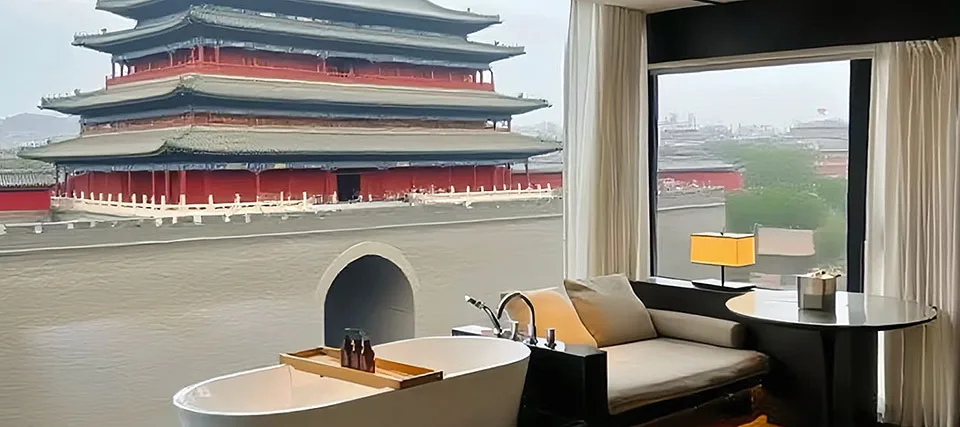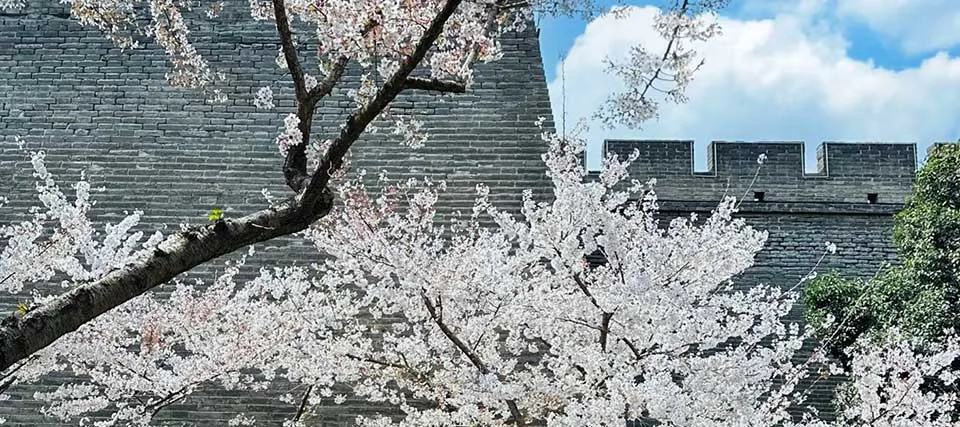Is Xi’an worth visiting? We can answer that question straight up! Yes, it is. As a city with a soul, Xi’an is the counter to Beijing’s seriousness and the commercialism of Shanghai. Steeped in some of China’s most interesting cultural heritage – it was home to a total of 13 dynasties, including the Qin, Han, and Tang dynasties – Xi’an is an ancient capital on par with Rome, Athens, and Cairo. With a history stretching back more than 3,000 years, Xi’an is considered the birthplace of Chinese civilization and the Chinese nation. Significantly, it is also the eastern starting point of the ancient Silk Road. Today, Xi’an stands at the intersection of history and contemporary advances. It is a city where millennia old relics coexist with world class infrastructure. At ChinaTours.com we unequivocally love Xi’an and feel certain you will too once you discover the 6 reasons for visiting.
#1 – Xi’an is an accessible city

Xi’an has rapidly transformed into one of China’s most accessible and welcoming cities for international travelers, thanks to its world-class aviation and transit infrastructure. Xianyang International Airport is the ninth busiest in China, serving over 47 million passengers annually. It connects seamlessly through major hubs like Beijing, Shanghai, and Hong Kong. While direct flights from places like the United States and Australia remain limited, the journey becomes an engaging prelude to arrival. Foreign passport holders can now take advantage of the 240-hour visa-free transit policy, enabling up to 10 days of exploration while en route to a third country. Once in Xi’an, the city’s expansive 12 line metro system, integrated with over 500 bus routes and various airport shuttle bus services, ensures every major cultural landmark is easily accessible.
Transportation in Xi’an goes far beyond convenience. It is an experience in itself. Metro Line 14 directly links the airport with central districts in under 70 minutes, with fares starting at less than 1USD. Tourist-friendly day and multi-day metro passes, bilingual signage, and QR-based ticketing systems make navigation intuitive for non-Chinese speakers. Travelers can reach major attractions like the Terracotta Warriors and Mount Huashan via dedicated tourist buses or high-speed rail, while the Chang’an Tong Card offers frequent rider discounts. Note, however, while it is possible to take the metro from Xi’an to the Terracotta Army, just keep in mind the closest station is five kilometres away. That means an additional bus is required to get to the museum. Intercity travel is just as efficient, with high-speed trains connecting Xi’an to Beijing and Shanghai in under six hours, supported by seamless metro-rail-airport connectivity.
Xi’an’s digital ecosystem is another highlight of its tourism renaissance. The city has embraced mobile payments to an unprecedented degree, allowing international visitors to link their Visa, Mastercard, or other global cards directly to Alipay and WeChat Pay. With no service fees for small purchases and generous spending limits, this system removes one of the biggest historical travel hurdles in China. Coupled with multilingual services at major sites, free public Wi-Fi, Tang Dynasty cultural experiences, and wide card acceptance at hotels, Xi’an is undoubtedly a city where holiday makers can travel with ease.
#2 – Xi’an is exceptional value

As seasoned travelers know, true luxury isn’t about spending more. It’s about experiencing more for what you invest. Yes, Xi’an delivers world-class heritage sites, but it’s also known for generous hospitality. Whether you’re going all out or on a budget, Xi’an will meet you where you’re at.
Accommodation options extend from budget to four and five star hotels, a range that is reflected on the dining front too. Feeling adventurous? Dive into some of Xi’an incredible street food. We can vouch for it: you’ll have trouble walking past the venues offering hand-pulled noodles biangbiang noodles and the famous Xi’an burger roujiamo. Naturally there are up market and fine dining options too, including Michelin star and Black Pearl restaurants. Our tip? Research, plan ahead, and talk to your local guide for suggestions. That way you’ll have a direct local experience that will bring the city alive for you.
Attractions are well priced, but it’s advisable to book ahead to avoid disappointment, while getting around is easy. Choose from the metro, Didi, and taxis, or arrange a private driver and guide to ensure you make the most of your available time.
#3 – Xi’an’s has world class historical and archeological sites

Xi’an is recognised as the cradle of Chinese civilization. Boasting over 30 National Key Cultural Relics Protection Units, in Xi’an you will find archeology, art, traditional craftsmanship, historical buildings, and dishes that have been eaten for centuries.
A must is the Mausoleum of the First Qin Emperor and the Terracotta Army with the world’s largest painted terracotta army of over 8,000 life size figures arranged in battle formation and preserved in situ since its 1974 discovery. Nearby, just 1.5 kilometers to the east, explore the Qin Shi Huang’s Mausoleum mound, the largest imperial tomb in China. It covers a huge 56 square kilometers and remains largely unexcavated, encapsulating two millennia of funerary innovation.
The Xi’an City Wall is the oldest and most completely preserved city fortification in China. Stretching 13.7 kilometers around the Ming era city center, its ramparts and watchtowers provide a continuous, walkable military perimeter that predates European bastion walls by centuries. Allow a full morning or afternoon to truly appreciate it.
Your travels in China will reveal many pagodas, but perhaps none so famous as the Big Wild Goose Pagoda (652 CE). The tallest surviving Tang dynasty structure in China, this pagoda is 64 meters high and is a testament to early Buddhist translation efforts on the Silk Road. The Forest of Stone Steles Museum preserves the world’s most extensive collection of ancient Chinese calligraphy and engraved epigraphy, with more than 3,000 inscribed stone slabs dating from the Han to Qing dynasties.
A short journey east of Xi’an brings you to Mount Hua (Huashan), one of China’s Five Great Mountains and a revered Taoist sanctuary. Towering peaks soar to 2,154 meters above sea level, linked by sheer granite cliffs, narrow plank trails, and ancient temple pavilions. The mountain strikes a dramatic landscape and is worth a visit if time and your stamina permit.
#4 – Xi’an has great weather perfect for travel

For the best experience of Xi’an, choose the right season. Both spring and autumn months deliver ideal conditions, with temperatures ranging from 10 °C to 20 °C. Spring (March to May) brings gentle warmth and blooming cherry and peach blossoms, while autumn (September to November) offers mild days, cool evenings, and the brilliant yellow of ginkgo-lined avenues. Both seasons feature fewer than 10 rainy days per month, ensuring you can wander freely through Big Wild Goose Pagoda’s gardens or cycle atop the City Wall without unexpected downpours.
Summer isn’t off limits, however. Running from June to August, during this season Xi’an offers lush greenery and cooler mornings after afternoon showers, perfect for early hikes on Mount Huashan or evening strolls through Grand Tang Everbright City. Our top tip: Avoid the peak heat around mid-July when temperatures can spike above 32 °C. By contrast Winter (December to February) brings crisp, clear days and the chance to see light snow on ancient walls and courtyards; daytime highs around 5 °C make midday visits to the Shaanxi History Museum especially pleasant.
The short story? Xi’an typically enjoys over 200 days of sunshine and low humidity. These factors make traveling to this great city totally worth it.
#5 – Xi’an’s food is sensational

Xi’an’s culinary landscape offers foreign travellers a rich and immersive experience that bridges ancient traditions with modern flair. Rooted in its Silk Road heritage, local cuisine emphasizes bold, robust flavors, flour-based staples, slow-braised meats, and aromatic spices like cumin and chili. Iconic dishes such as roujiamo (Xi’an hamburger), biangbiang noodles (hot oil noodles), yangrou paomo (flatbread in mutton broth), and liangpi (cold noodles) highlight the city’s unique taste profile. Each dish not only satisfies the palate but also tells a story of cultural endurance, especially within the vibrant Muslim Quarter, where halal variations and centuries-old techniques persist.
Street food in Xi’an is more than a quick bite. It’s a daily ritual woven into the fabric of city life. From the sensory overload of the Muslim Quarter, with its lamb skewers and steaming noodle soups, to the bustling stalls of Xiaonanmen Morning Market, where Zeng Gao (sticky rice cakes) and Hulatang (hot peppery meatball soup) showcase breakfast traditions, travellers can experience local rhythms unfold from sunrise to late night. Hidden alleys near the ancient city wall reveal a different side of Xi’an after dark. Venture out when the sun goes down and enjoy charcoal grills, sizzling noodles, and rare regional snacks, like luzhi liangfen.
For those seeking elevated dining, Xi’an’s fine dining venues present a striking contrast to its rustic roots. Heritage-focused establishments like Xi’an Restaurant honor old world craftsmanship through signature dishes like gourd shaped fried chicken, sauteed spicy pork kidneys, and Shaanxi braised beef shank.
Beyond regional fare, Xi’an’s global culinary footprint is growing. Travelers of all tastes can enjoy international cuisines, vegetarian restaurants, and even robotic hot pot experiences. There really is no limit. For a theatrical, communal encounter, dumpling banquets at renowned spots like Defachang deliver a multi-course exploration of China’s most beloved comfort food. Whether indulging in street food snacks or fine dining, you will find that Xi’an’s food scene is both authentic and refreshingly diverse.
#6 – Xi’an is safe for international travelers

Xi’an is a safe destination for international travelers. It consistently scores well on the safety index, which is why visitors can move around the city with confidence. Of course, basic travel awareness applies in bustling areas like the vibrant Muslim Quarter, but day or night, Xi’an is a city that welcomes travelers.
There you have it. Six reasons Xi’an is worth visiting in every sense. It is safe, accessible, affordable, and historically fascinating. It has great weather and even better food. As a standalone destination of part of a longer China tour, we’re confident you’ll agree Xi’an is a city to add to your must see city list.
Ready to pack your bags? Talk to our friendly team about including Xi’an in your upcoming China tour.




 First Time Traveller 10/10
First Time Traveller 10/10





